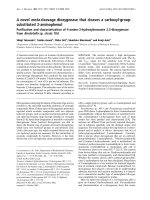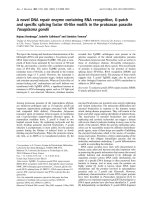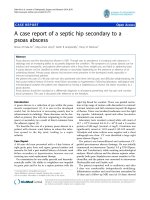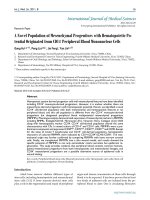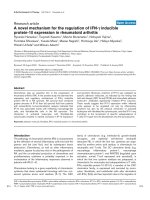Báo cáo y học: "A novel PTCH1 germline mutation distinguishes basal cell carcinoma from basaloid follicular hamartoma: a case report" pdf
Bạn đang xem bản rút gọn của tài liệu. Xem và tải ngay bản đầy đủ của tài liệu tại đây (739.45 KB, 4 trang )
BioMed Central
Page 1 of 4
(page number not for citation purposes)
Journal of Medical Case Reports
Open Access
Case report
A novel PTCH1 germline mutation distinguishes basal cell
carcinoma from basaloid follicular hamartoma: a case report
Ali Hellani
1
, Hiba Baghdadi
1
, Nidal Dabbour
2
, Nidal Almassri
3
and
Khaled K Abu-Amero*
4
Address:
1
PGD laboratory, Saad Specialist Hospital, Al-khobar, 31952 Saudi Arabia,
2
Dermatology Department, Saad Specialist Hospital, Al-
khobar, 31952 Saudi Arabia,
3
Pathology and Laboratory Medicine Department, Saad Specialist Hospital, Al-khobar, 31952 Saudi Arabia and
4
Molecular Genetics Laboratory, College of Medicine, King Saud University, Riyadh, Saudi Arabia
Email: Ali Hellani - ; Hiba Baghdadi - ; Nidal Dabbour - ;
Nidal Almassri - ; Khaled K Abu-Amero* -
* Corresponding author
Abstract
Introduction: Nevoid basal cell carcinoma syndrome is a rare autosomal dominant disorder
characterized by numerous basal cell carcinomas, odontogenic keratocysts of the jaws and
developmental defects. The disorder results from mutations in the PTCH1 gene.
Case presentation: A 15-year-old boy presented to our dental clinic with multiple jaw cysts. The
patient had broad confluent eyebrows, a broad base of the nose, frontal bossing and palmoplantar
pits. Examination of the jaw cysts revealed many keratinizing cysts without granular cell layers a
finding that raised the suspicion of nevoid basal cell carcinoma. Radiological examinations showed
calcification of the falx cerebri, spina bifida, bifid thoracic ribs and frontal bossing. Histopathological
examination showed basaloid proliferation in the upper dermis with follicular differentiation
surrounded by a loose mucinous stroma and retraction artifacts. These features make it difficult to
differentiate between nevoid basal cell carcinoma and basaloid follicular hamartoma, especially the
presence of these findings on a non-hairy area. BCL-2 staining was positive in the periphery of the
basaloid proliferation, which is typical of basaloid follicular hamartoma, and not in a diffuse pattern,
which is typical of nevoid basal cell carcinoma. The proband's siblings and parents were healthy with
no family history of this condition in the extended family. Since histology was equivocal and
palmoplantar pits are seen in both basaloid follicular hamartoma and nevoid basal cell carcinoma,
molecular genetic investigation was necessary to differentiate between the two potential diagnoses.
After sequencing the entire PTCH1 gene, we detected a single nucleotide deletion (c.1291delC) in
codon 431 of the PTCH protein, which resulted in a premature stop translation at residue 431.
This de novo mutation was not detected in both parents and in 100 normal volunteers of matching
ethnicity.
Conclusion: Screening the PTCH1 gene for mutations helped to differentiate between basaloid
follicular hamartoma and nevoid basal cell carcinoma and confirmed the diagnosis.
Published: 9 February 2009
Journal of Medical Case Reports 2009, 3:52 doi:10.1186/1752-1947-3-52
Received: 11 June 2008
Accepted: 9 February 2009
This article is available from: />© 2009 Hellani et al; licensee BioMed Central Ltd.
This is an Open Access article distributed under the terms of the Creative Commons Attribution License ( />),
which permits unrestricted use, distribution, and reproduction in any medium, provided the original work is properly cited.
Journal of Medical Case Reports 2009, 3:52 />Page 2 of 4
(page number not for citation purposes)
Introduction
Nevoid basal cell carcinoma syndrome (NBCC; also
known as Gorlin syndrome; MIM #109400) is a rare auto-
somal dominant disorder characterized by numerous
basal cell carcinomas, odontogenic keratocysts of the
jaws, and developmental defects such as bifid ribs, intrac-
ranial calcification, and polydactyly [1]. NBCC also pre-
disposes individuals to a variety of low-frequency tumors
such as ovarian fibroma, medulloblastoma, rhabdomy-
osarcomas, and cardiac fibromas [1]. Multiple organ sys-
tems may be impacted in NBCC. Abnormalities of the
skin, the skeletal system, the genitourinary system, and
the central nervous system (CNS) are the most common.
The approximate prevalence is reported to be one case per
56,000–164,000 population. The prevalence is likely to
be considerably higher in individuals younger than 20
years who present with basal cell carcinomas (BCC). The
syndrome has been documented for 50 years, but recent
developments in molecular genetics have dramatically
increased our understanding of its pathophysiology. The
disorder results from mutations in the PTCH1 gene, the
human homolog of the Drosophila segment polarity gene,
patched (MIM # 601309). PTCH1 has been mapped to
9q22.3-q31 and consists of 23 exons spanning approxi-
mately 50 kb and encoding a 1447-amino acid transmem-
brane glycoprotein. PTCH protein is involved in Sonic
hedgehog (Shh) signaling, where it is thought to act as a
receptor for Shh ligands [2]. An important clue to the
understanding of PTCH function comes from the study of
its interactions with another membrane protein
smoothened (Smo). In the absence of Shh signal, PTCH
represses the constitutive signaling activity of Smo, by
forming a PTCH-Smo complex [2]. Pathogenic mutations
in the PTCH1 gene result in the failure of PTCH to inhibit
Smo, leading to the constitutive activity of the Shh signal-
ing pathway [3]. The Shh signaling pathway has been
implicated in the formation of embryonic structures and
tumorigenesis [4]. Therefore, a disorder of this pathway
could result in an abnormal body conformation and tum-
origenesis as seen in NBCC patients. To date, over 100
PTCH1 germline mutations associated with NBCC have
been reported, most (73%) identifying nonsense or
frameshift mutations leading to the synthesis of a trun-
cated PTCH protein [5]. These mutations appear to be
mainly clustered into the large extra- and intracellular
loops of the PTCH protein, but no apparent genotype-
phenotype correlations have been established.
Case presentation
A 15-year-old boy presented to our dental clinic because
of multiple jaw cysts. The patient had the following clini-
cal features: tall stature, broad confluent eyebrows, broad
base of the nose, frontal bossing, palmoplantar pits (Fig-
ure 1A), and pectus excavatum (Figure 1B). Intellectually,
the patient was normal with an above average intelligence
level in school. Both parents and siblings were normal
and there was no family history of such a condition or
intellectual impairment in their extended family. His-
topathological examination of the jaw cysts revealed
keratinizing cysts lined by stratified squamous epithelium
with variable cell thickness. Keratinization appeared to be
abrupt with lack of a granular cell layer.
The presence of multiple jaw cysts devoid of a granular
layer raised the suspicion of nevoid basal cell carcinoma.
The patient had multiple palmoplantar pits. His radiolog-
ical examinations revealed calcification of the falx cerebri
(Figure 1C), spina bifida, bifid thoracic ribs and frontal
bossing.
Histopathological examination showed nests of tumor
cells in the superficial dermis. These nests were character-
ized by proliferation of basaloid cells with palisading
nuclei at the periphery of the nests. The stroma around the
tumor had loose mucinous changes and retraction arti-
facts (Figure 1D). This appearance can be seen in both
NBCC and basaloid follicular hamartoma (BFH). The
presence of retraction artifacts favors NBCC; however, the
pattern of immunostaining for bcl-2 with only focal cellu-
lar staining rather than the diffuse pattern (Figure 1E) was
more consistent with BFH [6].
Since the histology was ambiguous and palmoplantar pits
are seen in both BFH and NBCC, molecular genetic inves-
tigation was necessary to differentiate between the two
entities. In order to do this, genomic DNA was amplified
and the entire coding region and the exon-intron bound-
aries of the PTCH1 gene were sequenced as detailed previ-
ously [7]. Briefly, PTCH1 sequences were amplified from
100 to 200 ng of DNA using specific primers (5 μM),
dNTP (5 mM), PCR buffer 10×, and one unit of Expand
Long Taq polymerase (Roche). Polymerase chain reaction
(PCR) products were purified using a Qiagen purification
kit and then assessed on the capillary electrophoresis bio-
analyzer using the DNA 7500 chip. The purified PCR
product was sequenced on an ABI 3130xI Genetic Ana-
lyzer using forward and reverse primers described previ-
ously [7]. After sequencing the entire PTCH1 gene, we
detected a single nucleotide deletion (c.1291delC) in
codon 431, which resulted in a premature stop translation
at residue 431 (Figure 1F). Since the PTCH1 encodes
1447-amino acid transmembrane glycoprotein, the pre-
mature stop-codon found at codon 431 is expected to
have a deleterious effect on protein structure and func-
tion. This de novo mutation (c.1291delC) was not detected
in either parents or in 100 normal volunteers of matching
ethnicity. This mutation is located in the extracellular
domain of the PTCH protein, which is known to be an
important domain that interacts with the Shh ligand [8]
and is expected to inactivate the protein ability to bind the
Journal of Medical Case Reports 2009, 3:52 />Page 3 of 4
(page number not for citation purposes)
Shh ligand. As a consequence of mutation identification
and confirmation of the NBCC diagnosis, the manage-
ment protocol for this patient would be: (i) surgical exci-
sion of any basal cancer cells; (ii) avoidance of sun
exposure and any kind of radiotherapy; (iii) annual fol-
low-up for the development of skin lesions and (iv)
genetic counseling.
Discussion
Nevoid basal cell carcinoma syndrome is a rare autosomal
dominant disease characterized by developmental abnor-
malities and tumorigenesis. Mutation of the PTCH1 gene
is the molecular defect associated with this syndrome.
According to the human genome mutation database [9],
there are currently 224 mutations reported to date (data-
base updated May 2008) in the PTCH1 gene. Here, we
describe a patient who presented with a clinical picture
that was consistent with NBCC, but overlapped with BFH.
Therefore, molecular genetic study was necessary in order
to differentiate between the two entities. PTCH1 was
investigated because PTCH1 mutations are the typical
cause of NBCC, but not of BFH syndrome, where the caus-
ative gene is not yet known. Sequencing the PTCH1 gene
revealed the presence of a de novo mutation (c.1291delC)
that was not detected in either parents or in 100 normal
volunteers of matching ethnicity. According to the PTCH
mutation database and human mutation database, the de
novo mutation (c.1291delC) detected in our patient has
not been reported previously. Since this mutation will
introduce a premature stop-codon early in translation, we
expect this mutation to have serious consequences on the
(A) Palmoplantar pits biopsied and non-biopsiedFigure 1
(A) Palmoplantar pits biopsied and non-biopsied. (B) Pectus excavatum. (C) Calcification of the falx cerebri. (D) The
superficial dermis contains nests of basaloid tumor cells with peripheral palisading nuclei surrounded by mucinous stroma. (E)
BCL-2 immunostaining illustrates focal brown staining of the tumor cells. Many of the tumor cells lack BCL-2 expression. (F)
Chromatogram showing the forward sequencing results of the PTCH1 gene for the patient and his parents. The arrow indicates
the position of the deleted nucleotide "C" in the patient. The sequence after the deleted "C" in the patient was deteriorated as
expected when a sequence deletion is present.
Publish with BioMed Central and every
scientist can read your work free of charge
"BioMed Central will be the most significant development for
disseminating the results of biomedical research in our lifetime."
Sir Paul Nurse, Cancer Research UK
Your research papers will be:
available free of charge to the entire biomedical community
peer reviewed and published immediately upon acceptance
cited in PubMed and archived on PubMed Central
yours — you keep the copyright
Submit your manuscript here:
/>BioMedcentral
Journal of Medical Case Reports 2009, 3:52 />Page 4 of 4
(page number not for citation purposes)
formation of mature protein and ultimately it will have
deleterious consequences on protein function.
NBCC is malignant so that early detection and confirmed
diagnosis are of paramount importance and will help
avoiding unnecessary radiotherapy treatment for brain
tumors usually developed by these patients.
Molecular genetic testing will be helpful to confirm the
diagnosis in patients with atypical phenotype or possibly
for prenatal diagnosis. Molecular testing may be useful for
infants of an affected patient who is too young to have
developed diagnostic clinical findings. Additionally, anal-
ysis of the PTCH1 gene in NBCC will provide important
information not only for genetic counseling, but also for
further research of the correlation between PTCH1 geno-
type and NBCC phenotype. We recommend that any
patient with multiple jaw cysts and or palmoplantar pits
should be evaluated by a dermatologist to look for the
clinical findings of Gorlin syndrome.
Conclusion
Screening of the PTCH1 gene for mutations is of para-
mount importance in confirming the diagnosis for this
autosomal dominant syndrome.
Abbreviations
BFH: basaloid follicular hamartoma; CNS: central nerv-
ous system; NBCC: nevoid basal cell carcinoma syn-
drome; PTCH: patched homolog (Drosophila); Shh:
Sonic hedgehog; Smo: smoothened
Consent
Written informed consent was obtained from the parents
of the patient for publication of this case report. A copy of
the written consent is available for review by the Editor-in-
Chief of this journal.
Competing interests
The authors declare that they have no competing interests.
Authors' contributions
AH was in charge of design and overall supervision of the
study. HB carried out the sequencing of the gene while
ND was involved in the clinical evaluation of the patient.
NA was in charge of the histopathological evaluation of
the patient while KKA performed the analysis of the
genetic data and drafted the manuscript.
Acknowledgements
The authors thank Saad Specialist Hospital for their financial support. Dr
Abu-Amero is supported by grants from the Glaucoma Research Chair at
the Dept. of Ophthalmology, College of Medicine, King Saud University,
Riyadh, Saudi Arabia.
References
1. Gorlin RJ: Nevoid basal cell carcinoma syndrome. Dermatol Clin
1995, 13(1):113-125.
2. Stone DM, Hynes M, Armanini M, Swanson TA, Gu Q, Johnson RL,
Scott MP, Pennica D, Goddard A, Phillips H, Noll M, Hooper JE, de
Sauvage F, Rosenthal A: The tumour-suppressor gene patched
encodes a candidate receptor for Sonic hedgehog. Nature
1996, 384(6605):129-134.
3. Bale AE, Yu KP: The hedgehog pathway and basal cell carcino-
mas. Hum Mol Genet 2001, 10(7):757-762.
4. Hardcastle Z, Mo R, Hui CC, Sharpe PT: The Shh signalling path-
way in tooth development: defects in Gli2 and Gli3 mutants.
Development 1998, 125(15):2803-2811.
5. Lindstrom E, Shimokawa T, Toftgard R, Zaphiropoulos PG: PTCH
mutations: distribution and analyses. Hum Mutat 2006,
27(3):215-219.
6. Ramos-Ceballos FI, Pashaei S, Kincannon JM, Morgan MB, Smoller BR:
Bcl-2, CD34 and CD10 expression in basaloid follicular
hamartoma, vellus hair hamartoma and neurofollicular
hamartoma demonstrate full follicular differentiation. J
Cutan Pathol 2008, 35(5):477-483.
7. Li TJ, Yuan JW, Gu XM, Sun LS, Zhao HS: PTCH germline muta-
tions in Chinese nevoid basal cell carcinoma syndrome
patients. Oral Dis 2008, 14(2):174-179.
8. Gailani MR, Stahle-Backdahl M, Leffell DJ, Glynn M, Zaphiropoulos
PG, Pressman C, Unden AB, Dean M, Brash DE, Bale AE, Toftgård R:
The role of the human homologue of Drosophila patched in
sporadic basal cell carcinomas. Nat Genet 1996, 14(1):78-81.
9. Stenson PD, Ball EV, Mort M, Phillips AD, Shiel JA, Thomas NS,
Abeysinghe S, Krawczak M, Cooper DN: Human Gene Mutation
Database (HGMD): 2003 update. Hum Mutat 2003,
21(6):577-581.
